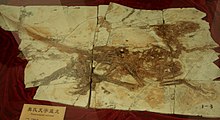Tianyuraptor
|
Tianyuraptor Temporal range: Early Cretaceous, 122 Ma |
|
|---|---|
 |
|
| Holotype specimen | |
| Scientific classification | |
| Kingdom: | Animalia |
| Phylum: | Chordata |
| Class: | Reptilia |
| Clade: | Dinosauria |
| Order: | Saurischia |
| Suborder: | Theropoda |
| Family: | †Dromaeosauridae |
| Clade: | †Microraptoria |
| Genus: |
†Tianyuraptor Zheng et al. 2010 |
| Species: | †T. ostromi |
| Binomial name | |
|
Tianyuraptor ostromi Zheng et al., 2010 |
|
Tianyuraptor is a genus of short-armed dromaeosaurid dinosaur ('running lizard'; a type of small dinosaur considered to be closely related to birds) that lived during the Early Cretaceous, about 122 million years ago. Its remains have been found in western Liaoning, China. It was similar to other dromaeosaurids found in Liaoning, with the exception of being somewhat more primitive. The type specimen, formally named in 2010, shows features not seen in previously known Northern Hemisphere (Laurasian) dromaeosaurids, but present in Southern Hemisphere (Gondwanan) species and early birds. Because of this, the scientists who first studied Tianyuraptor described it as a "transitional species", bridging the gap between northern and southern types of dromaeosaurid. Tianyuraptor also differs from previously known dromaeosaurids in that it possesses a relatively small furcula ("wishbone"), and unusually short forelimbs.
The generic name of Tianyuraptor combines Tianyu, referring to the Shandong Tianyu Museum of Nature where the holotype specimen is stored, with raptor, the Latin word for 'robber', referring to the action of grabbing prey, often used in naming dromaeosaurids. The specific epithet, ostromi, is in honor of John Ostrom, who contributed greatly to the study of dromaeosaurid fossils, including Deinonychus and feathered dinosaurs.
Tianyuraptor is a medium-sized dromaeosaurid that has several derived features that separate it from other dromaeosaurids. These include the length of the middle caudal (tail) vertebrae being more than twice that of the dorsal (back) vertebrae, a small and extremely slender furcula, and an unusually long hindlimb that is roughly three times as long as the entire series of dorsal vertebrae. As in other dromaeosaurid fossils discovered in Liaoning, the tail is relatively long at 960 millimetres (38 in), nearly 4.8 times as long as the femur.
...
Wikipedia
